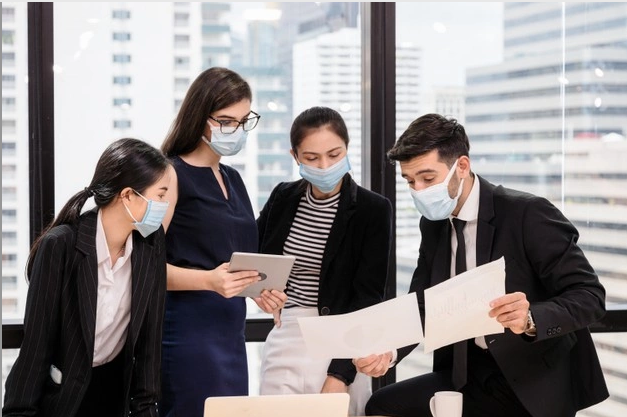The COVID-19 pandemic has impacted everything and everybody. This isn’t a newsflash for anyone at this point almost a year into the crisis. In addition to our reactive response, oral surgery practices really need to have a plan that includes not only the facility, team members, the customers, and the vendors in a return-to-work scenario, but also contingency scenario plans for future crises and a notion of what permanent changes will be made in a “new normal” environment. It’s important to stay up to date with current regulations and keep reviewing your COVID-19 pandemic plan to keep your surgery safe.
Without a mitigation plan, COVID-19 transmission can occur during dental procedures easily. A recent COVID-19 Department of Labor Occupational Risk Study revealed that dentists, dental hygienists, and dental assistants have infection risk scores in the top 10% of well-known professions (92.1, 99.7, and 92.5 out of 100 respectively). Another study measuring antibody levels in dentists versus the general population determined that levels for a number of viruses found in saliva such as cytomegalovirus, influenza virus, and respiratory syncytial virus were more common in dentists and tend to increase with time.
The Occupational Health and Safety Administration (“OSHA”) identified Dental Health Care Professionals (“DHCPs”) as being at “very high risk” of exposure to known or suspected sources of the virus. This is true, in part, because the Centers for Disease Control (“CDC”) believed dental facilities would have a hard time meeting standards for airborne precautions which include infection isolation rooms or single-patient rooms, a respiratory protection program, and N95 respirators. If this isn’t reason enough for a mitigation plan, the short-term health effects for DHCPs include headaches, dry skin, itchy eyes, sneezing, coughing, and fatigue. Long-term exposure can cause COPD, lung cancer, and asthma, among others.
So, how should a surgery practice approach scenario planning in the current health crisis and beyond? To answer that, we should recap what we know and don’t know about COVID-19. We find ourselves at an inflection point. On one hand, we do know that:
- The common flu has resulted in up to 5M severe cases every year and 650,000 deaths
- The common flu has a regular season, but COVID-19 does not
- COVID-19 behaves a bit like the common flu, but is more contagious
- Most people experience symptoms akin to a cold or the common flu;
- COVID-19 has been most severe in the elderly and immunocompromised, who are a relatively small part of the population.
- We also know that the global death toll (July 22, 2020) exceeds 625,000 and that mutations of the virus have occurred, which may bring more serious symptoms to younger people.
- And last, but not least, social distancing and face masks are more effective in preventing infection than we thought
On the other hand, we are still learning:
- How many “waves” of the COVID-19 virus we will have;
- What the unusual inflammatory syndrome tied to COVID infections in some children is;
- What level of immunity people who have recovered from the virus have, how effective antibodies from survivors will be in preventing infection in others exactly;
- And how many, and how virulent, future mutations or new virus strains will be.
Given that backdrop, what do dental practices need to consider in their recovery and reopening planning? Many healthcare facilities that have workers on premises now, and that will be adding more as we restart the economy, are/will be using infrared thermometers and other tests to check temperature of employees and patients before they are admitted to the workplace. The Americans with Disabilities Act (“ADA”) permits employers to conduct medical examinations to determine fitness for work, whether the employee has a disability or not. The Act does not define “medical examination,” but the courts have suggested criteria to determine whether a procedure is a medical examination. For a fuller explanation of “medical examination” under the ADA and what testing may or may not be permissible, see the guidance from the U.S. Equal Employment Opportunity Commission. Along with this sort of testing, employers also need to be aware of employee and patient privacy rights.
In addition to testing and privacy concerns, employers need to be aware of the Families First Coronavirus Response Act. This legislation expands the Family and Medical Leave Act (FMLA) to include leave for full- and part-time employees who are unable to work (or telework) because they must care for a son or daughter under 18 years of age, and because school or daycare is closed, or the child-care provider is unavailable, when a federal, state or local authority has declared an emergency due to the COVID-19 virus. Litigation has already begun addressing situations where an employee who does not otherwise meet the criteria of the Act refuses to return to work for fear of being infected and loses unemployment benefits and/or is terminated.
All this certainly can be daunting; but, as we pointed out in previous posts in this series, technology like the MaxilloSoft software solution can assist practice managers in dealing with the effects of the pandemic. MaxilloSoft capabilities such as patient intake and consent forms, and automated reminders/notices can be adopted to communication needs during the pandemic. Online intake forms can be customized to incorporate COVID-19 precautions for staff and employees. E-prescriptions can be sent to pharmacies instantly, circumventing the need for staff and patients to handle paper prescriptions that may contain virus microbes. In the end, your plan to address the pandemic will convey your concern for the well-being of team members, and visitors, and make your office safer place.

